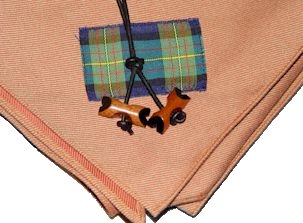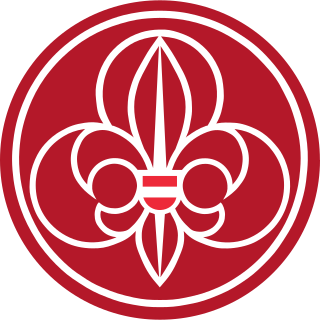
Scouting, also known as the Scout Movement, is a worldwide youth social movement employing the Scout method, a program of informal education with an emphasis on practical outdoor activities, including camping, woodcraft, aquatics, hiking, backpacking, and sports. Another widely recognized movement characteristic is the Scout uniform, by intent hiding all differences of social standing in a country and encouraging equality, with neckerchief and campaign hat or comparable headwear. Distinctive uniform insignia include the fleur-de-lis and the trefoil, as well as merit badges and other patches.

A Scout is a child, usually 10–18 years of age, participating in the worldwide Scouting movement. Because of the large age and development span, many Scouting associations have split this age group into a junior and a senior section. Scouts are organized into troops averaging 20–30 Scouts under the guidance of one or more Scout Leaders or Scoutmasters. Troops subdivide into patrols of about 6–8 Scouts and engage in outdoor and special interest activities. Troops may affiliate with local, national, and international organizations. Some national Scouting associations have special interest programs such as Air Scouts, Sea Scouts, outdoor high adventure, Scouting bands, and rider Scouts.

A neckerchief, sometimes called a necker, kerchief or scarf, is a type of neckwear associated with those working or living outdoors, including farm labourers, cowboys and sailors. It is most commonly still seen today in the Scouts, Girl Guides and other similar youth movements. A neckerchief consists of a triangular piece of cloth or a rectangular piece folded into a triangle. The long edge is rolled towards the point, leaving a portion unrolled. The neckerchief is then fastened around the neck with the ends either tied or clasped with a slide or woggle.

Wood Badge is a Scouting leadership programme and the related award for adult leaders in the programmes of Scout associations throughout the world. Wood Badge courses aim to make Scouters better leaders by teaching advanced leadership skills, and by creating a bond and commitment to the Scout movement. Courses generally have a combined classroom and practical outdoors-based phase followed by a Wood Badge ticket, also known as the project phase. By "working the ticket", participants put their newly gained experience into practice to attain ticket goals aiding the Scouting movement. The first Wood Badge training was organized by Francis "Skipper" Gidney and lectured at by Robert Baden-Powell and others at Gilwell Park in September 1919. Wood Badge training has since spread across the world with international variations.

Scouts Canada is a Canadian Scouting association providing programs for young people, between the ages of 5 and 26, with the stated aim "To help develop well rounded youth, better prepared for success in the world". Scouts Canada, in affiliation with the French-language Association des Scouts du Canada, is a member of the World Organization of the Scout Movement. In 2021–22, youth membership stood at 33,899, a 48% decline from 64,693 in 2014–15. Over the same period, volunteer numbers also declined 43%, from 20,717 in 2015 to 11,765 in 2022. Scouts Canada has declined significantly in size since its peak: youth membership is down 82% from 288,084 in 1965 and volunteer numbers are down 50% from 33,524 in 1965.

Scouts UK (also known as The Scout Association) is the largest Scout organisation in the United Kingdom. It's the World Organization of the Scout Movement's recognised member for the United Kingdom.

Malaysian Scouts Association is the largest informal youth and educational organisation in Malaysia, and member of World Organization of the Scout Movement (WOSM).

Cub Scouting is part of the Scouting program of the Boy Scouts of America (BSA), available to boys and girls from kindergarten through fifth grade, or 5 to 10 years of age and their families. Its membership is the largest of the five main BSA divisions. Cub Scouting is part of the worldwide Scouting movement and aims to promote character development, citizenship training, personal fitness, and leadership.

Sea Scouts is a program of the Boy Scouts of America for young men and women ages 14 through 20.

Explorer Scouts, frequently shortened to Explorers, is the fifth section of The Scout Association in the United Kingdom for 14- to 18-year-olds. The section was introduced in 2001 and formally launched in February 2002, alongside Scout Network, to replace the former Venture Scout section for fifteen-and-a-half to twenty-year-olds.

Pfadfinder und Pfadfinderinnen Österreichs is the largest Scouting and Guiding organization in Austria and the only one approved by World Association of Girl Guides and Girl Scouts (WAGGGS) and the World Organization of the Scout Movement (WOSM). The association claims more than 300 troops with more than 85,000 Scouts nationwide. WOSM and WAGGGS give quite smaller membership values for the PPÖ: 27,274 members in WOSM and 10,508 members in WAGGGS.

A woggle is a device to fasten the neckerchief, or scarf, worn as part of the Scout or Girl Guides uniform, originated by a Scout in the 1920s.

The Boy Scouts of America (BSA) use uniforms and insignia to give a Scout visibility and create a level of identity within both the unit and the community. The uniform is used to promote equality while showing individual achievement. While all uniforms are similar in basic design, they do vary in color and detail to identify the different membership divisions of Cub Scouting, Scouts BSA and Venturing. Many people collect BSA insignia such as camporee and jamboree emblems, council shoulder strips and historical badges.

Scouting Nederland is the national Scout organisation of the Netherlands with approximately 110,000 members (53,324 male and 54,663 female, 87,000 youth members, as of 2010.
Girl Guides of Canada is the national Guiding association of Canada. Guiding in Canada started on September 7, 1910, and GGC was among the founding members of the World Association of Girl Guides and Girl Scouts (WAGGGS) in 1928.
Beavers is a programme associated with some Scouting organisations generally for children aged 5/6 to 7/8 who are too young for the Cub programme.

Savez Izviđača Crne Gore is the national Scouting organization of Montenegro. A referendum on independence was held in Republic of Montenegro on May 21, 2006, voting to leave its state union with Serbia by a narrow margin. Montenegro became the world's 192nd recognized sovereign state, which then split the Savez Izviđača Srbije i Crne Gore, as happened with Czechoslovakia in 1993, meaning that Savez Izviđača Crne Gore had to reapply for World Organization of the Scout Movement membership in 2008.

Savez Izviđača Srbije, English: Scout Association of Serbia) is the primary national Scouting organization of Serbia. A referendum on independence was held in Montenegro on May 21, 2006, voting to leave its state union with Serbia by a narrow margin. Montenegro became the world's 193rd recognized sovereign state, which has then split the Savez Izviđača Srbije i Crne Gore, as happened with Czechoslovakia in 1993, meaning that the membership in the World Organization of the Scout Movement was transferred to Savez Izviđača Srbije.

The Pathfinder & Rover Explorer Scouts' Association (P-RESA) is an independent Traditional Scouting Association in the United Kingdom, with International branches. The Association's training programme runs along the lines of Baden-Powell's original Scouting for Boys, upholding the traditions and practices set out by B-P, using the 1938 Boy Scouts' Association Policy Organisation & Rules (POR) as its basis.

The Irish Girl Guides is a Girl Guides organisation in the Republic of Ireland. Together with the Catholic Guides of Ireland, it forms the Council of Irish Guiding Associations. Whereas the Catholic Guides are an all-Ireland body, the Irish Girl Guides are not organised in Northern Ireland, where Girlguiding Ulster, the branch of Girlguiding UK, operates instead.


















